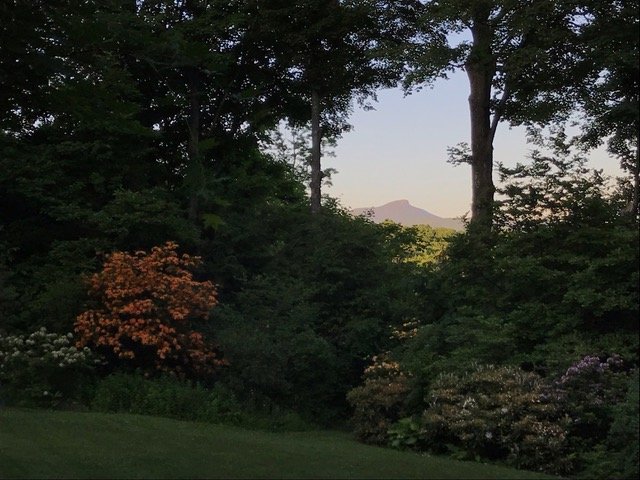The concept of a botanical/public garden seems to be a natural progression of the work we’ve done here in our garden on Lincoln Hill and speaks to a long history of agricultural use on the Hill. The agricultural history of this land dates back to 1795 when Schubael Clark and his wife Violet, free African Americans from Connecticut, first cleared this land which was continuously and successfully farmed until the 1870s by two generations of their descendants. ( See “Discovering Black Vermont,by Elise Guyette, University of Vt. Press). Following a period of various owners trying to eke out a living on these stony hill-side soils, the land became fallow sometime in the 1950s. When my wife Mary Crane and I arrived on the site in 1984 and began to build our home, the young regenerating forest was once again modified, this time to create a house site and our first nascent gardens.
As an adolescent, my first interest in horticulture started when my father took me to a bonsai lecture and demonstration. Something clicked and that led to the start of my own collection of bonsai followed soon by the development of a Japanese stroll garden in my family’s suburban New Jersey backyard. This was then followed by the construction of my first alpine rock garden. During high school, money earned from a paper route would buy rock garden and other exotic ornamental plants from specialty mail order or local nurseries. These early interests motivated an easy decision to pursue a college degree in horticulture. After earning an associate degree in Ornamental Horticulture from the State University of NY, Morrisville in 1976, and a BS in Plant and Soil Science from UVM in 1978, I worked at various Vermont garden centers and landscaping firms before starting my own business, Champlain Valley Landscaping, in 1980. An acre or so of land adjacent to our new home was still an open field and the stoney but fertile soil was a workable location, and in 1985, a rare plant nursery was started. The idea was to augment my budding landscape design and construction business with locally grown plants, and overtime, unique, specimen size trees and shrubs would become signature pieces in many of my garden designs. The nursery still persists, but is evolving from its more commercial past toward what Mary describes as an “Un-intended Arboretum” - a place to walk among a fair number of slowly maturing unusual deciduous trees, shrubs, and conifers- all in rather free range setting.
As our family grew, so did the gardens. The well-drained acidic soils proved ideal for my growing interest in testing the cold hardiness of a wide variety of plants from the north temperate regions of the world. A budding friendship with Kate Brook Nursery owner and esteemed Vermont plantsman Greg Williams of Wolcott, Vermont, fueled my early interest in learning about, and then growing, various species and cultivars of conifers. Visits to Greg’s amazing collection of plants on a cold hillside in Wolcott inspired me to plant species that I assumed I could never grow here in Vermont. A true plant wizard, teacher and friend, his knowledge was endless and inspired much of my landscape design work, as well as how I developed my own garden here on Lincoln Hill . Many of the early additions to the garden that came from Greg’s Nursery have now reached specimen size and form the framework for a wide variety of other herbaceous and woody plants accumulated over the past 40 years.
In addition to conifers and alpine plants, I soon focused on another lifelong plant passion - Rhododendrons. With advice from an older, more experienced generation of Vermonters such as azalea grower Louis Edebohl, gardening in the very cold area of Hardwick, VT and Dr. Norman Pellett, professor of Ornamental Horticulture at UVM, I began to collect and evaluate deciduous azaleas and rhododendrons that might be able to survive our harsh Vermont winters. After more than 40 years in this pursuit, the collection has grown to well over 150 species and cultivars, making it one of the largest in the state. In those years when the winter low temperatures are not too extreme, some variety of rhododedron or azalea can be found in bloom in our garden every day starting late April right though the summer into early August.
Over time, new gardens have been added – rock and alpine gardens, a stream garden, a formal garden dubbed the “ Wedding Garden” - but primarily the garden attempts to weave itself into the edges of a forested Vermont hillside. Shady spots harbor mature herbaceous plants such as the familiar Hosta, Actea, and Rodgersia to name just a few, set among a framework of azaleas, mountain laurel and evergreen rhododendron. Specimen size, slow-growing conifers add massing, diverse architectural form, and four season interest - in many ways these evergreens are truly the bones of my garden.
Probably best described as a “mini” botanical garden, the roughly two acres of gardens and adjacent “un-attended arboretum” ( my description), the Lincoln Hill Botanical Garden will offer plenty of interest to both beginning gardeners and hard core plant enthusiasts. We hope sharing our garden with the public will foster an appreciation of the diversity - and beauty - cultivating ornamental plants can bring to our life experience.
Paul Wieczoreck - Proprietor/Head Gardener

